
The Solar-Terrestrial Centre of Excellence (STCE) is a collaborative network of the Belgian Institute for Space Aeronomy, the Royal Observatory of Belgium and the Royal Meteorological Institute of Belgium.
 |
Published by the STCE - this issue : 4 Jul 2013. The Solar-Terrestrial Centre of Excellence (STCE) is a collaborative network of the Belgian Institute for Space Aeronomy, the Royal Observatory of Belgium and the Royal Meteorological Institute of Belgium. |
| Archive of the newsletters | Subscribe to this newsletter by mail |
Last week, the remainder of a large sunspot complex rounded the west limb. For more than 2 weeks, it had dominated the outlook of the Sun. Initially consisting of 6 groups, only the two largest groups survived the transit over the solar disk. The graph underneath shows the daily sunspot number from 9 till 30 June as determined from SDO/HMI continuum images (1024x1024; http://sdo.gsfc.nasa.gov/data/ ).
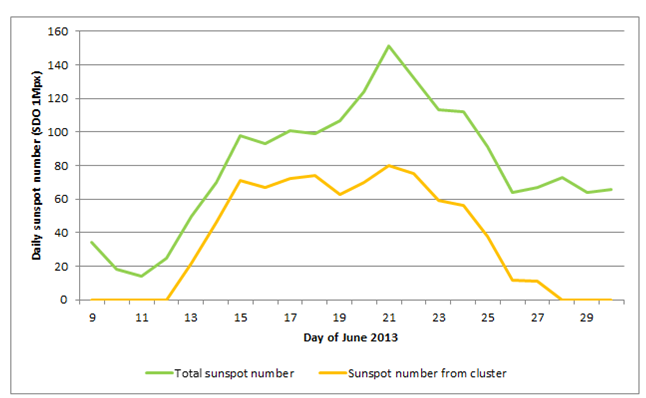
As can be seen, this sunspot cluster pushed the daily sunspot number to a higher level for more than a week. On some days, it contributed as much as 75% of the total sunspot number. The 6 groups were packed together in an area measuring roughly "only" 220 times the surface of the Earth. Images underneath show the cluster on 15 June (all 6 groups) and on 21 June (most flares in one day). Most prominent were active regions NOAA 1772 (stretched region on the right) and NOAA 1775 (compact region to the left).
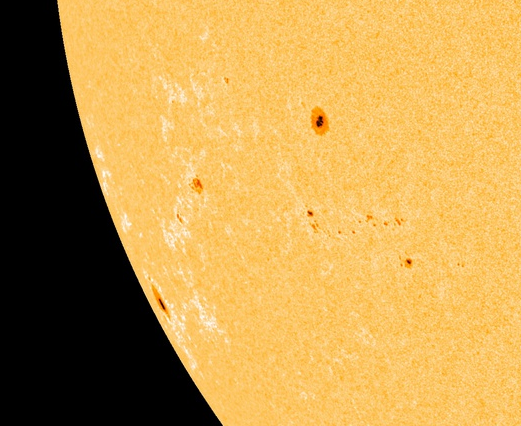
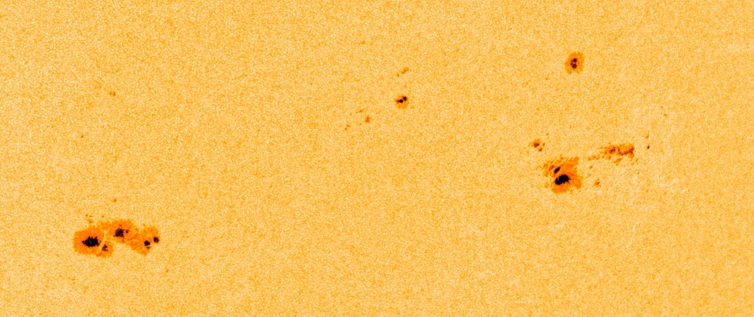
Despite the high sunspot numbers, flare activity from these mostly simple regions remained modest. During the visibility period of the sunspot cluster, about 80% of its 25 flares had their origin in either NOAA 1772 or NOAA 1775. These were all relatively weak C-class flares, no medium-class flares were registered. The peak in flare activity on 21 June corresponds to an upswing in sunspot area in NOAA 1772. It is noteworthy that none of the two M-class flares during this period were produced by one of the cluster groups, as can be seen e.g. in this news item at http://www.stce.be/news/204/welcome.html on the 21 June event. NOAA 1775 really did not live up to the expectations, despite some spots with opposite magnetic polarity being close together.
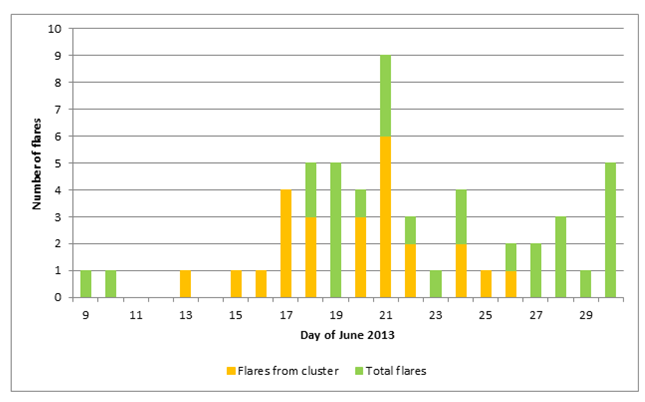
The appearance of this kind of sunspot group clusters is not so unusual. Quite often, these regions do produce substantial solar flares during their transit. A nice example is a trio of large sunspot groups that was visible from 21 July till 4 August 2002 in an area that was comparable in size to the most recent outbreak (SOHO-image underneath; http://sohowww.nascom.nasa.gov/ ). At the time, the 3 groups produced a total of 78 flares, including 10 M-flares and 2 strong X-class flares. A really good reason to keep an eye on those sunspot's nests!
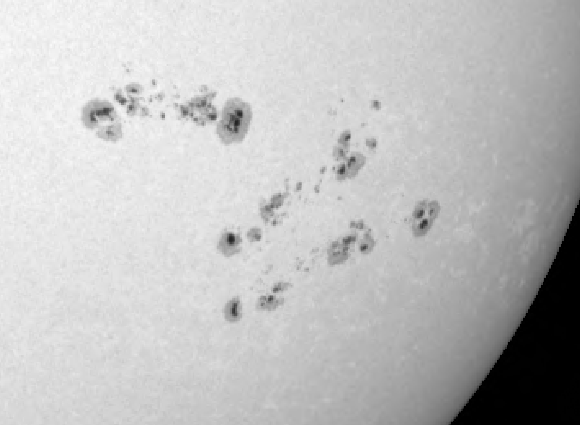
The sixth Coronal Loop Workshop (CLW6 - http://www.stce.be/coronalloops/ ) took place in La Roche-en-Ardenne (Belgium) from 25 till 27 June. Organized by the Solar-Terrestrial Centre of Excellence (STCE), it gathered more than 60 scientists from all over the world discussing the latest in coronal loops research. Understanding the fine-structure and evolution of these loops is of fundamental importance in our knowledge on solar eruptions and on the million degree hot corona, thus providing key elements on space weather itself.
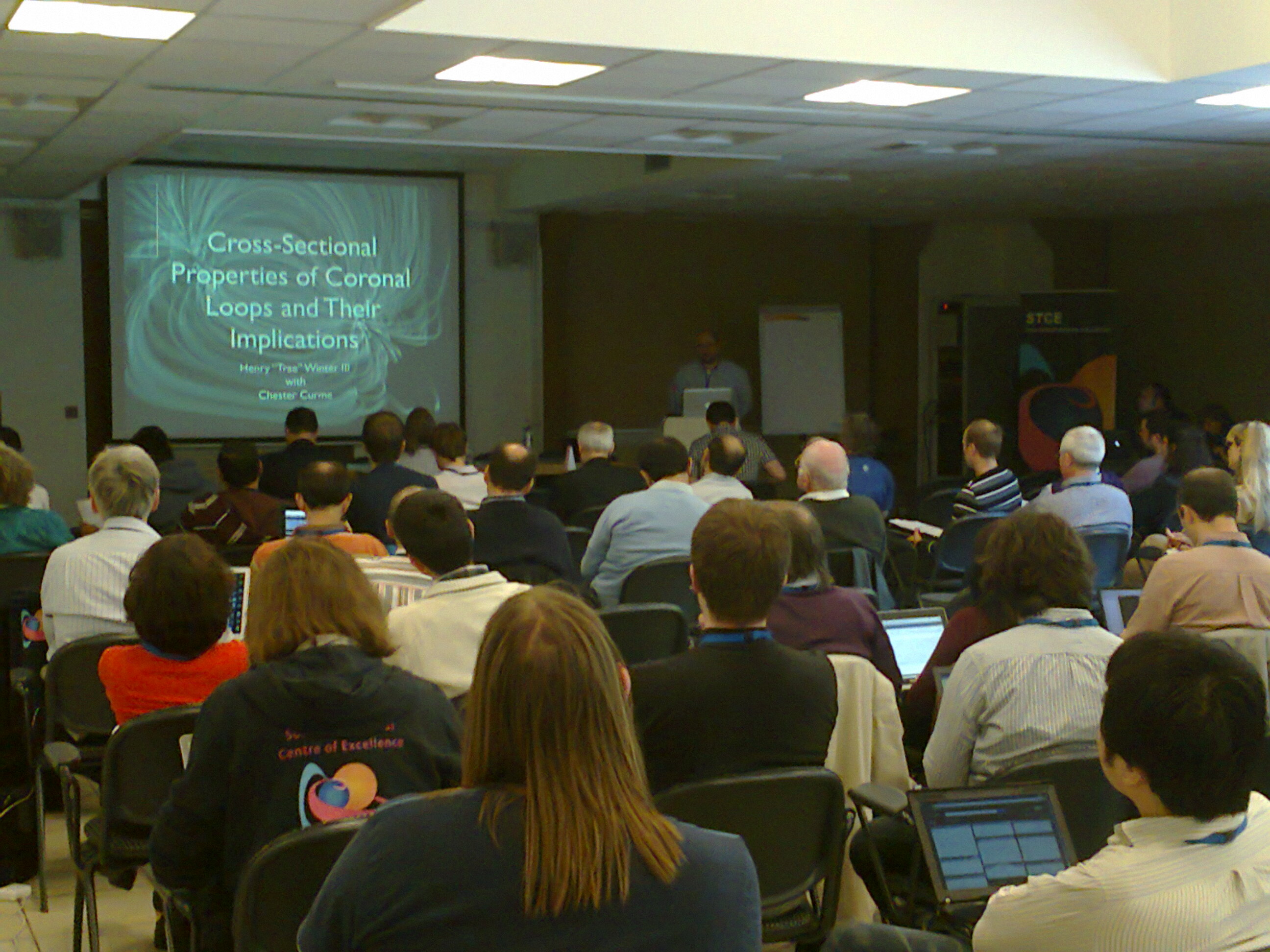
The 36 oral presentations and 33 posters focused on the 4 main topics of the workshop. These concerned the temporal and spatial resolution of the images and data, the energy release in the corona, insights in the way the different layers of the solar atmosphere are coupled, and the tools that are required to observe the various features and their key characteristics. Despite the different points of views, the discussions were courteous, constructive and inspiring. No wonder that in some cases the Q-and-A session lasted longer than the presentation itself!
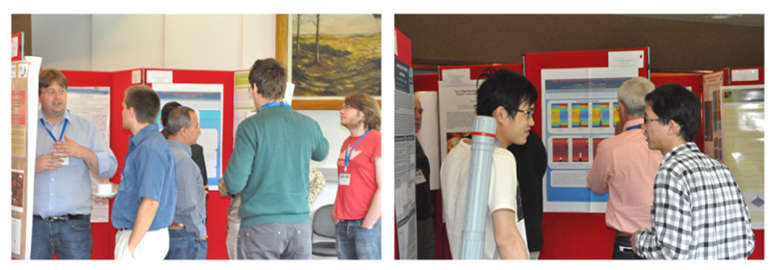
Another interesting aspect was that data and imagery of many solar observing satellites were used. So, aside the obvious SDO, SOHO and STEREO, satellites such as Hinode, Coronas-F and RHESSI were regularly mentioned too. Quite a few talks featured also the latest results from the High-Resolution Coronal Imager (Hi-C; http://www.nasa.gov/topics/solarsystem/features/hic-briefing-materials.html ). This EUV-telescope was launched on 11 July 2012 aboard a NASA sounding rocket and gathered only for about 5 minutes worth of imagery. However, its resolution was 5 times better than the current SDO-images (see comparison underneath), and the results obtained so far excite the entire coronal loop research community.
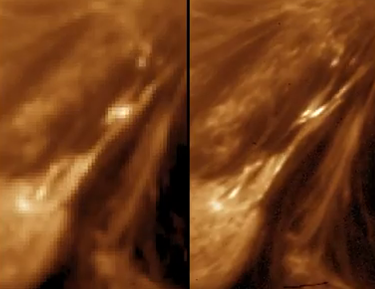
The participants also cheered the successful launch of IRIS (Interface Region Imaging Spectrograph). This satellite will study the interface region of the solar atmosphere and will hopefully shed more light on how the Sun manages in just a few kilometers to increase the temperature of her atmosphere by a factor of 100. The mission should last 2 years, and will probably give the researchers a lot to talk about during CLW7. This workshop is scheduled for 2015, and the venue is expected to be somewhere warmer and drier than the scenic but rainy La Roche-en-Ardenne.
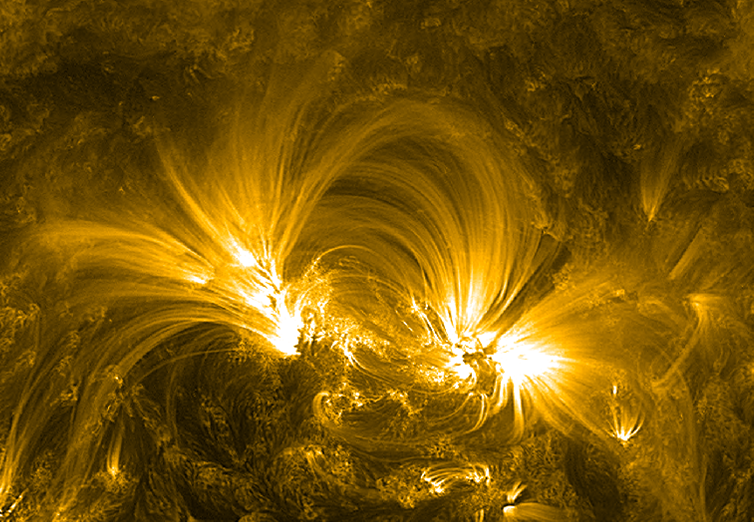
Solar activity was at eruptive levels (at least one C flare a day) for the entire week. 18 C-class solar flares were registered, from active regions NOAA 11778, 11781, 11775, 11774, 11776, 11777 and 11780.The proton event from the M2-flare (21 June) ended on 24 June.
During the period, various filament eruptions occurred. Most of these were not squarely directed to the Earth or were backside events. Notable eruptions were the 25 June event on the northern hemisphere (just north of an equatorial coronal hole), and the 27/28 June eruptions in NOAA 11777 (southern hemisphere).
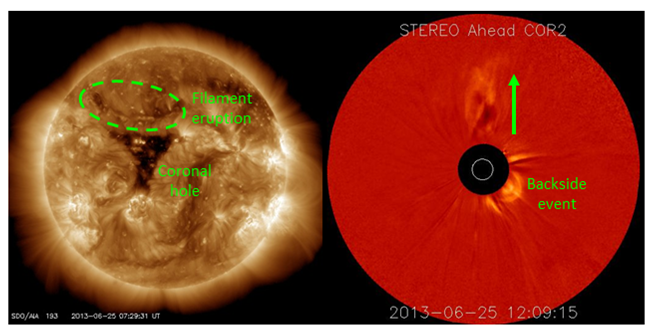
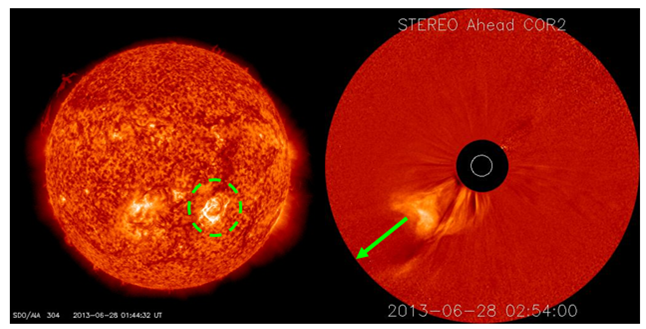
Solar (flaring) activity was very low to low this week. A new set of sunspot groups emerged around the East limb, but not much activity has been seen.
In order to view the activity of this week in more detail, we suggest to go to the following website from which all the daily (normal and difference) movies can be accessed: http://proba2.oma.be/ssa.
This page also lists the recorded flaring events.
Further details about some of this week's events, can be found below.


On Tuesday, a huge filament erupted during the morning in the Northern hemisphere. By doing so, it expanded an already big and north-centered coronal hole. Find a SWAP movie of this event here (SWAP difference movie).
Another small eruption took place near the south west limb (image underneath).
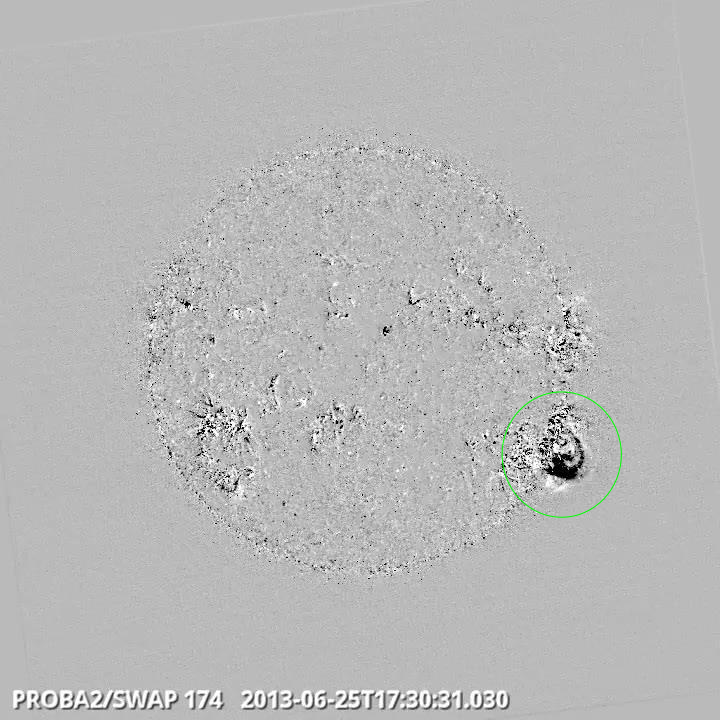
This eruption caused a minor geomagnetic storm on June 30 when it reached Earth.
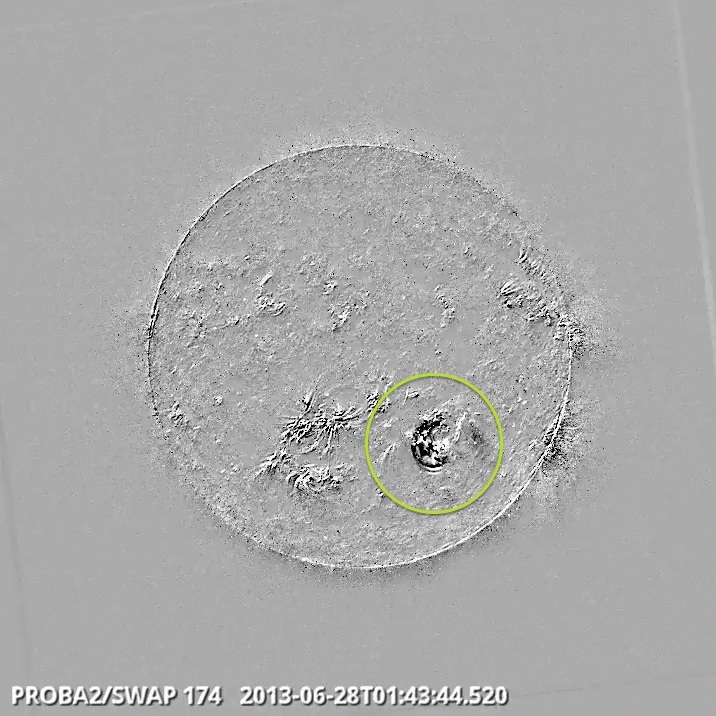
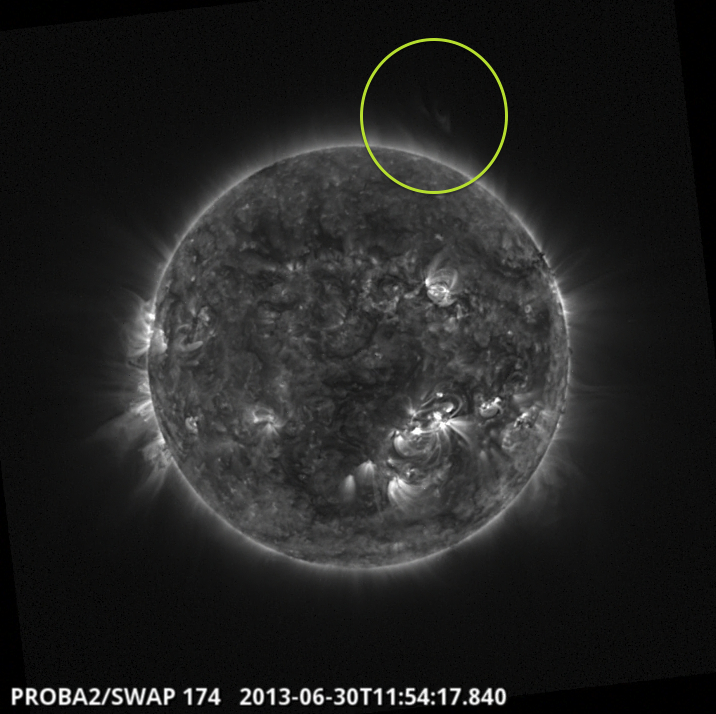
The geomagnetic field was at unsettled to active levels from 23 till 25 June due to the high speed stream of a coronal hole, and at quiet levels on 26 and 27 June.
Around noon on 27 June, a jump in solar wind speed (from about 370 km/s to 460 km/s) and other parameters was observed. This was probably due to a (modest) hit from one of the many coronal mass ejections (CMEs) from the previous days. This resulted in active geomagnetic levels early on 28 June. In the course of 28 June, the magnetic field of the solar wind turned southward and maintained a nearly constant value around -11 nT until noon the next day. The solar wind speed then gradually started to increase from 360 km/s up to values of 550 km/s late 30 June, with a weakening magnetic field and "hotter" particles. This corresponded to the arrival of high speed stream of the coronal hole that had passed the Sun's central meridian on 25-26 June.
The sustained negative values of the solar wind for nearly 20 hours on 28 and 29 June resulted in minor to strong geomagnetic storm levels (Dourbes: minor storm).
Though there certainly seems to have been some pushing from the coronal hole's fast solar wind stream on the slower moving trailing part of the CME, the geomagnetic storm seems mainly to be due to the long-lasting southward field inside the magnetic cloud.
The afternoon of 30 June saw a return to unsettled and active levels.
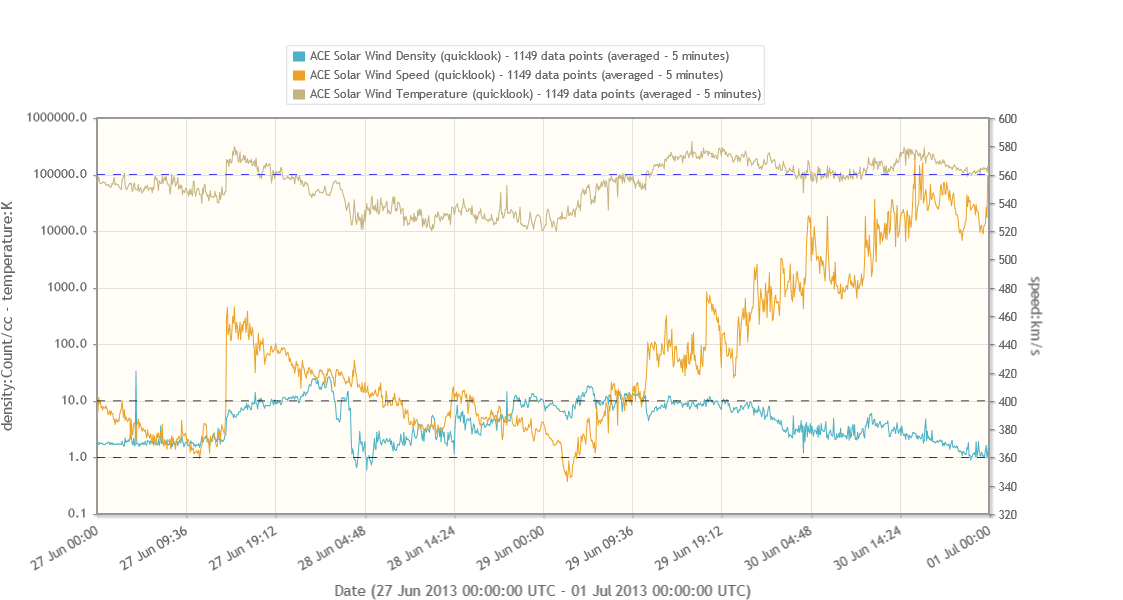
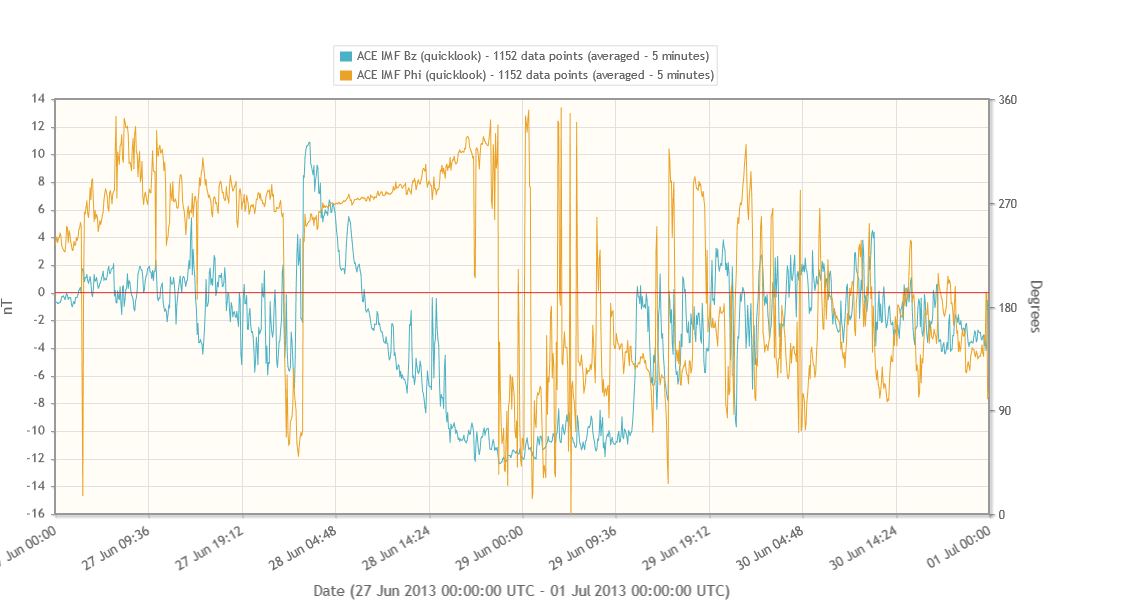
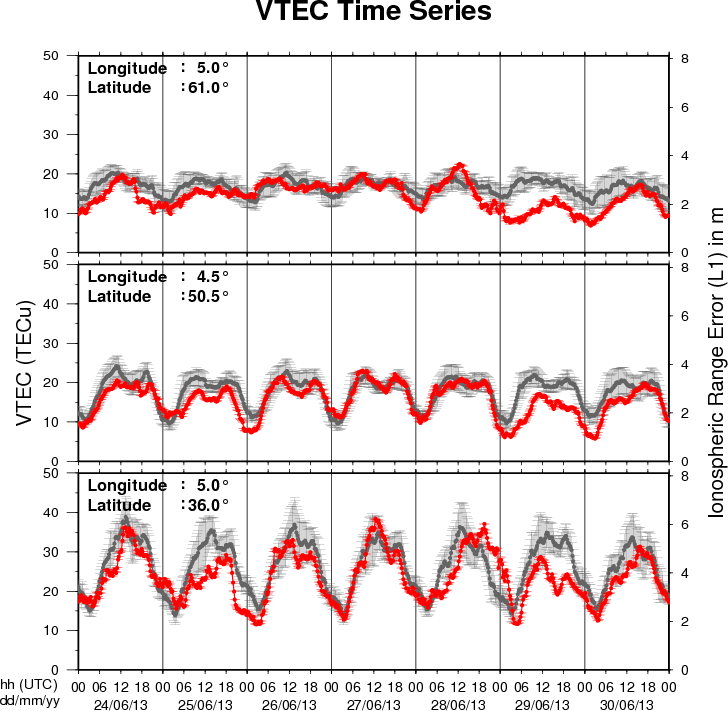
The figure shows the time evolution of the Vertical Total Electron Content (VTEC) (in red) during the last week at three locations:
a) in the northern part of Europe(N61°, 5°E)
b) above Brussels(N50.5°, 4.5°E)
c) in the southern part of Europe(N36°, 5°E)
This figure also shows (in grey) the normal ionospheric behaviour expected based on the median VTEC from the 15 previous days.
The VTEC is expressed in TECu (with TECu=10^16 electrons per square meter) and is directly related to the signal propagation delay due to the ionosphere (in figure: delay on GPS L1 frequency).
The Sun's radiation ionizes the Earth's upper atmosphere, the ionosphere, located from about 60km to 1000km above the Earth's surface.The ionization process in the ionosphere produces ions and free electrons. These electrons perturb the propagation of the GNSS (Global Navigation Satellite System) signals by inducing a so-called ionospheric delay.
See http://stce.be/newsletter/GNSS_final.pdf for some more explanations ; for detailed information, see http://gnss.be/ionosphere_tutorial.php
This lecture was given at MIRA Public Observatory on 5 June. It is an introduction to solar observations both in white light as in H-alpha. It gives a general overview on telescopes and filters to be used, observation methods, know-how of a solar observation, solar features to be monitored, data exploitation, internet links,... (15 attendees; in Dutch).
http://www.spaceweather.eu/en/repository/show?id=473
Start : 2013-07-08 - End : 2013-07-09
The goal of the symposium is to present and discuss new results
on solar activity and its manifestations in the entire heliosphere,
including geospace and other planetary environments. The new
space-borne solar observatories (SDO, Hinode, STEREO) have recently
made important new discoveries on the dynamics of the magnetized
solar atmosphere and solar wind, and on solar eruptive events that
are the main driver of variable conditions in geospace and other
planetary environments.
We now also better understand the changes of long-term solar
activity, from the low levels of 100 years ago to the all-time
maximum in the late 1950s, and to the very weak activity of the
recent minimum. Although solar and geomagnetic activity during the
ongoing cycle 24 has remained abnormally low, the increasing
activity after the long solar quiescence has recovered the
attention to space weather.
We solicit presentations covering the entire domain from the
solar surface (and below) to the heliopause, covering all time
scales of variations from a fraction of a second to millenia. The
practical aspects of solar-driven variability in space environments
(space weather) and the long-term changes in the solar activity and
its effects in the heliosphere (space climate) will be covered as
well.
Website:
http://theory.physics.helsinki.fi/~ravainio/ewass-13/
Start : 2013-07-12 - End : 2013-07-19
Applications are invited for the 2013 Heliophysics Summer
School, which will be held in beautiful Boulder, Colorado. We are
seeking students and undergraduate level teachers and instructors
to join us this coming summer for a unique professional experience.
Students and teachers will learn about the exciting science of
heliophysics as a broad, coherent discipline that reaches in space
from the Earth's troposphere to the depths of the Sun, and in
time from the formation of the solar system to the distant future.
At the same time, a goal of the Summer School is for the group of
instructors to develop materials from Heliophysics that can be
applied in their classes.
The Heliophysics Summer School focuses on the physics of space
weather events that start at the Sun and influence atmospheres,
ionospheres and magnetospheres throughout the solar system. The
solar system offers a wide variety of conditions under which the
interaction of bodies with a plasma environment can be studied:
there are planets with and without large-scale magnetic fields and
associated magnetospheres; planetary atmospheres display a variety
of thicknesses and compositions; satellites of the giant planets
reveal how interactions occur with subsonic and sub-Alfvenic flows
whereas the solar wind interacts with supersonic and super-Alfvenic
impacts.
Encompassed under a general title of comparative magnetospheres
are processes occurring on a range of scales from the solar wind
interacting with comets to the interstellar medium interacting with
the heliosphere. The school will address not only the physics of
all these various environments but will also go into the
technologies by which these various environments are being
observed. The program is complemented with considerations of the
societal impacts of space weather that affects satellites near
Earth and elsewhere in the solar system.
The school will be based on lectures, laboratories, and
recitations from world experts, and will draw material from the
three textbooks Heliophysics I-III, published by Cambridge
University Press.
Several teachers along with about 35 students will be selected
through a competitive process organized by the UCAR Visiting
Scientist Programs. The school lasts for eight days, and each
participant receives full travel support for airline tickets,
lodging and per diem costs.
Website:
http://www.vsp.ucar.edu/Heliophysics/
Start : 2013-07-16 - End : 2013-07-25
The Summer School Alpbach enjoys 36 years of tradition in
providing in-depth teaching on different topics of space science
& technology, featuring lectures and concentrated working
sessions on mission studies in self-organised working groups. 60
young highly qualified European science and engineering students
converge annually for stimulating 10 days of work in the Austrian
Alps. 4 teams compete to design a space mission judged by a jury of
experts. Students learn how to approach the design of a satellite
mission and explore new and startling ideas supported by experts.
The Summer School 2013 will focus on Space Weather
.
The purpose of the Summer School is to foster the practical
application of knowledge derived from lectures, to develop
organisational and team-work skills and to encourage creativity.
Teams will compete to design the best project, judged by an
independent jury. The teams themselves are responsible for the
selection of the subject of the project and for the team structure
and working methods.
Website:
http://www.summerschoolalpbach.at/
Start : 2013-07-22 - End : 2013-08-02
The CISM Summer School is intended to give students a
comprehensive immersion in the subject of space weather: what it
is, what it does, and what can be done about it. Space weather is
many things: beautiful when seen through the eyes of a sun-viewing
telescope, fascinating when studied for its alien worlds of
magnetic structures and phenomena, awesome when witnessed as a
solar eruption or auroral storm, and devastating to the users of
services it disrupts. Space weather links the Sun, the Earth, and
the space in between in a branching chain of consequences. Weather
systems on the Sun can spawn interplanetary storms of colossal size
and energy that envelop the whole planet in electrical hurricanes.
Such storms attack high-tech, complex, and expensive technological
systems that provide much of the infrastructure that allows modern
society to function.
Website:
https://www2.hao.ucar.edu/docs/2013-cism-summer-school
Start : 2013-08-05 - End : 2013-08-08
The goal of this workshop is to foster collaborations between
ground and space solar projects. This workshop is expected
* to provide a forum to discuss the use of current and future
observational solar facilities, and how to optimise their
scientific returns;
* to identify the potentially paradigm-shifting observations
that will become possible with the next generation ground- and
space-based solar telescopes and their advanced
instrumentation;
* to foster collaborations between researchers working at the
development of ground- and space-based projects and creation of
synergies between research programs at different wavelength
bands.
Website:
http://folk.uio.no/matsc/oslo-13/info.html
Start : 2013-08-05 - End : 2013-08-08
The goal of this workshop is to foster collaborations between
ground and space solar projects. This workshop is expected 1) to
provide a forum to discuss the use of current and future
observational solar facilities, and how to optimise their
scientific returns; 2) to identify the potentially
paradigm-shifting observations that will become possible with the
next generation ground- and space-based solar telescopes and their
advanced instrumentation; 3) to foster collaborations between
researchers working at the development of ground- and space-based
projects and creation of synergies between research programs at
different wavelength bands.
A workshop webpage and more information will follow shortly -
the purpose of this pre-announcement is to enable early bookings in
your calendar.
Start : 2013-08-16 - End : 2013-08-31
The Local Organising Committee and the Mexico National Committee
of IUGG have the great pleasure to welcome you to the 11th
Scientific Assembly of the International Association of
Geomagnetism and Aeronomy (IAGA) which is held in Mérida
Yucatán, Mexico from 26 to 31 August 2013 with the
motto: "Living on a Magnetic Planet". Our Magnetic Planet
Capricious (Changeable or Unpredictable) Field.
In order to increase the visibility and attractiveness of IAGA
to young researchers, to motivate them to play active role within
IAGA and to create (and enhance) their awareness of IAGA and sense
of belonging to IAGA, the first IAGA Summer School will be
organized just prior the Assembly. The summer school will provide
overview of the activities carried out within all the IAGA
divisions, with subjects from paleomagnetism and magnetic
anisotropy through observatories and geomagnetic field modeling to
ionospheric and aeronomic research. At least 20 young scientists
from all around the world will be invited based on the nominations
from Working Groups and Divisions. Special call and more
information will be published before the end of 2012.
Website: http://iaga2013.org.mx/
Start : 2013-08-25 - End : 2013-08-29
This conference will focus on instrumentation, observatories,
space missions, and programs for observations from the Sun to
Earth's upper atmosphere and space environment. The aim is to bring
together diverse communities working on all elements of solar
physics and space weather instrumentation.
Studying solar phenomena and monitoring space weather requires
observations using both space- and ground-based instrumentations
covering the different regions of the Sun-Earth system, the Sun,
interplanetary medium, magnetosphere, ionosphere, and thermosphere.
Papers are solicited concerning all instrumentation-supporting
solar physics and space weather. This includes, but is not limited
to, concepts, designs, fabrication processes, calibration, data
trending, information technologies, solar data mining, instrument
modeling, and satellite lifetime prediction modeling. We are also
interested in all past, current, and future solar space missions
and satellite and ground constellations of space weather
instrumentation with a strong focus on Space Situational
Awareness.
This conference is intended to provide the solar physics
community and that of Earth's space environment with a forum for
discussing the latest updates on instrumentation, observation
techniques, and programs in their respective fields, and for
proposing innovative ideas for future Sun-Earth coordinated
observations.
Website: http://spie.org/op423
Start : 2013-09-04 - End : 2013-09-06
The purpose of the meeting is to provide a forum for the italian
scientists in the field (some of which are abroad) to consolidate
on-going collaborations and establish new ones, for example in
future projects such as Solar Orbiter and EST, where several of us
are involved.
The meeting is obviously open to scientists from all the
countries!
Website:
http://www.oact.inaf.it/weboac/SoHe2013/
Start : 2013-09-08 - End : 2013-09-12
The European Solar Physics Meetings aim to highlight all aspects
of modern solar physics, including observation and theory that span
from the interior of the Sun out into the wider heliosphere. These
meetings provide a broad, yet stimulating, environment for European
and international scientists to share their research in solar
physics.
The meeting will mostly comprise of contributed talks and poster
presentations, with several invited review talks (typically one per
session). Posters will be on display for the whole meeting in close
proximity to the lecture theatre. Refreshments will be served in
the poster viewing area during two dedicated coffee/poster breaks
on each full day.
Website: http://www.espm14.ie/
Start : 2013-09-09 - End : 2013-09-14
We gain information about the universe through analysis of the
spectra from celestial objects. However, while the intensity
spectrum represents a scalar quantity but electromagnetic radiation
occurs in the form of transverse waves, the polarized spectrum
provides us with a 4-vector, the Stokes vector. The increased
amount of information space opens new windows to the universe, in
particular for the exploration of magnetic fields. It is well
recognized that the magnetic field is a primary agent responsible
for structuring and the source of all variability on intermediate
time scales, which manifests itself in all forms of solar and
stellar activity.
It is therefore not surprising that every year there are many
scientific meetings organized with the objective of studying the
role of magnetic fields in cosmic objects. What is largely missing
in these meetings is however an in-depth investigation of the
fundamental aspects of how magnetic fields can be determined by the
means of spectro-polarimetry, our main gateway to cosmic magnetism.
The primary aim of our series of Workshops is to address these
fundamental aspects, with less emphasis on the morphological and
physical properties of cosmic magnetic fields.
Website: http://spw7.ynao.ac.cn/
Start : 2013-09-16 - End : 2013-09-20
The meeting will cover a broad range of aspects of solar
physics, space science and solar-terrestrial relations. We aim to
include every side of solar and space research, including
observations, theory, and numerical modelling. The main idea behind
the meeting is to treat the entire solar-terrestrial domain as one
system, rather than each region independently.
The topics to be covered are:
* advanced solar observations
* waves and flows in the Solar atmosphere
* structure and dynamics of solar magnetic fields
* connecting analytical theory and modern numerical simulations
to observations
* new physics in numerical modelling
* linking solar interior with heliosphere
* particle acceleration in the Sun and heliosphere
* non-linear phenomena in space plasmas
* physics of magnetosphere and ionosphere
Website:
http://swat.group.shef.ac.uk/Conferences/Ukraine_UK_2013/index.html
Start : 2013-09-16 - End : 2013-09-19
This summer school targets to introduce a generation of young
researchers (advanced master students, PhDs, and junior
postdoctoral researchers) to the diverse aspects of space weather
related research.
It will introduce theoretical approaches to space weather and
its drivers, present modern solar data analysis tools, and cover
state-of-the-art solar and space science simulations. Participants
will learn about forecasting aspects and their quality control for
space weather events, but also experience hands-on training in
scientific proposal writing and receive do-and-don't tips for
scientific presentations.
The scientific program is enriched by a public evening lecture
on the solar influence on our climate, and the lecturers are
invariably expert scientists with international standing.
The school is open to a maximum of 40 participants, and can
benefit from its embedding within two international research
network activities: an Interuniversity Attraction Pole P7/08 CHARM
connecting heliospheric to astrophysical communities with 7 partner
institutes, and a European FP7 Project eHeroes with 15 different
partner institutes. Participation from outside both network
activities is strongly encouraged. Within Belgium, the school links
up expertise from universities (KU Leuven, ULB, Gent University) to
federal research institutes (the Solar-Terrestrial Centre of
Excellence, the Royal Observatory of Belgium and the Belgian
Institute for Space Aeronomy).
Website:
http://wis.kuleuven.be/CHARM/events/school/SSTW2013/
Start : 2013-10-07 - End : 2013-10-11
The aim of the workshop is to review the "state of the art"
theories about generation and propagation of Solar radio burst and
discuss the observational constrains and results that have been
provided in this area by the WIND & STEREO missions during the
last 20 years. Furthermore the STEREO & WIND observations will
be put in the context of other missions such as RHESSI and ground
based observatories. Finally, the preparation for the future
explorations foreseen with Solar Orbiter and Solar Probe Plus will
be discussed.
Website:
http://type3stereo.sciencesconf.org/
Start : 2013-10-24 - End : 2013-10-26
Initiated by Profs. Fang and Choudhury, the first Asian-Pacific
Solar Physics Meeting (APSPM) was held in Bangalore two years ago.
During the meeting, a consensus was achieved that it might be a
good idea to have the APSPM every three years. Somehow the second
APSPM was proposed to be held by mainland China in 2013. APSPM is
aimed to exchange the recent research results in solar physics in
the emerging asian-pacific region.
Asian-pacific regions are getting more and more active in solar
physics, as signified by the construction of big facilities,
including the Hinode satellite (Japan), SOXS (India), Chinese Solar
Radio Heliogragh, and Optical & Near-Infrared Solar Eruption
Tracer (ONSET). Therefore, colleagues have agreed to hold regional
solar physics meetings regularly. The first Asian-Pacific Solar
Physics Meeting (APSPM) was held in Bangalore during March 22-24
2011. During the meeting, a consensus was achieved that it might be
a good idea to have the APSPM every three years. Somehow the second
APSPM was proposed to be held by mainland China in 2013. APSPM is
aimed to exchange the recent research results in solar physics in
the emerging asian-pacific region.
Website:
http://sdac.nju.edu.cn/~solar/
Start : 2013-10-27 - End : 2013-10-31
Magnetic helicity has been intensively studied from
observational, theoretical, and many other aspects of solar
physics. For this meeting we would like to invite solar physicists
who are interested in the observational and theoretical studies of
the helicity, to encourage thorough discussions on the relevant hot
issues. The 1st Helicity Thinkshop was held successfully in 2009,
and now the 2nd one will be held on October 27-31, 2013 in Beijing,
China.
Website:
http://sun.bao.ac.cn/meetings/HT2013/
Start : 2013-11-11 - End : 2013-11-22
Magnetic fields play an important role in many astrophysical
processes. But magnetic are difficult to detect and to model or
understand, since the fundamental equations describing the behavior
of magnetized plasmas are highly non-linear. Hence, magnetic fields
are often an inconvenient subject which is overlooked or simply
neglected. Such difficulty burdens the research on magnetic fields,
which has evolved to become a very technical subject, with many
small disconnected communities studying specific aspects and
details.
The school tries to amend the situation by providing a unifying
view of the subject. The students would have a chance to understand
the behavior of magnetic fields in all astrophysical contexts, from
cosmology to the Sun. From star-bursting regions to AGNs in
galaxies. The school will present a balanced yet complete review of
our knowledge. Extensions into the unknown are also important to
indicate present and future lines of research.
The Winter School will bring together in a relaxed working
atmosphere a number of the leading scientists in this field, PhD
students and recent postdocs. The conditions for a successful
interaction will be granted, including two special sessions for
those students that want to present their own work.
Website:
http://www.iac.es/winterschool/2013/
Start : 2013-11-12 - End : 2013-11-15
Since its launch in Sep-2006, more than 600 refereed papers have
been published based on Hinode observations, presenting many new
and important findings to the scientific community. However, due to
the unexpectedly low levels of solar activity, until now the focus
has mainly been on the more quiescent aspects of the solar cycle.
With the solar maximum expected this year, through cooperative
observations with SDO, IRIS, and ground based observatories, Hinode
observations should lead to our understanding of active Sun
phenomena, such as solar flares and CMEs, to be greatly improved.
Making Hinode-7 an excellent opportunity to discuss solar activity
in the current solar cycle and the related science through the use
Hinode data, as well as other solar/space weather data. It will
also be interesting to use this meeting to broaden our focus to
include the solar-stellar connection as a means to deepen our
understanding of solar activity.
Momentum is also gaining for Solar-C, which is being developed
as an international collaboration between Japan, US and Europe. To
further discuss this mission, the Solar-C science meeting will be
held on 11-Nov.
Website:
http://www.kwasan.kyoto-u.ac.jp/hinode-7/
Start : 2013-11-18 - End : 2013-11-22
This International CAWSES-II Symposium hosted by SCOSTEP
(Scientific Committee on Solar-Terrestrial Physics) will provide an
excellent opportunity to discuss the scientific accomplishments of
CAWSES-II and look forward to SCOSTEP's future programs at a moment
toward the end of its five-year period. The symposium will cover
the six major themes of CAWSES-II tasks: 1) What are the solar
influences on the Earth's climate?, 2) How will geospace respond to
an altered climate?, 3) How does short-term solar variability
affect the geospace environment?, 4) What is the geospace response
to variable inputs from the lower atmosphere?, 5) Capacity
Building, 6) Informatics and eScience. The main functions of
CAWSES-II are to help coordinate international activities in
observations, modeling, and applications crucial to achieving this
understanding, to involve scientists in both developed and
developing countries, and to provide educational opportunities for
students of all levels. The symposium offers keynotes/lectures that
will be interesting for all participants every morning and more
specific sessions of presentations in the afternoon. We welcome all
those who are involved and/or interested in CAWSES-II to Nagoya in
the autumn when we will have the pleasure of being surrounded by
beautiful colorful leaves of this season.
Website:
http://www.cawses.org/CAWSES/leaflet_CAWSES-II_120229.pdf
Start : 2013-11-18 - End : 2013-11-22
The 10th Edition of the European Space Weather
Week will take place on 18-22nd
November 2013 in Belgium. The venue will be confirmed early next
year, but mark your calendars now for the 10th Anniversary of this
growing European event.
The ESWW will again adopt the central aim of bringing together
the diverse groups in Europe working on different aspects of Space
Weather
. This includes but isn't
limited to the scientific community, the engineering community,
applications developers, service providers and service end users.
The meeting organisation will again be coordinated by the Belgian
Solar-Terrestrial Centre of Excellence (STCE), ESA
and the Space Weather
Working Team. The local
organisation will be done by the STCE.
Website:
http://www.stce.be/esww10/
Start : 2014-08-02 - End : 2014-08-10
The 40th COSPAR Scientific Assembly will be held in Moscow,
Russia from 2 - 10 August 2014. This Assembly is open to all bona
fide scientists.
Website:
http://www.cospar-assembly.org/